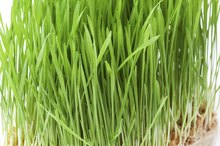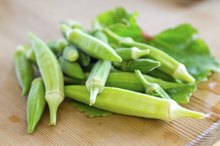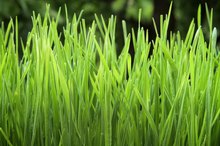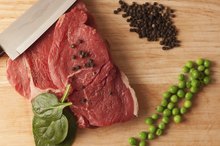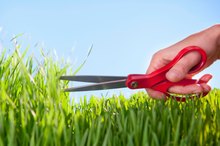Wheatgrass for Anemia
Purported to boost the immune system and help ward off disease, wheatgrass is a staple on many health-conscious menus. Although some of the claims surrounding the healing properties of wheatgrass lack scientific backing, this food does offer a wide spectrum of nutrients and phytochemicals that can help you stay healthy. Due to its iron content, wheatgrass may be helpful in treating iron deficiency anemia.
Description
Anemia occurs when your body has a shortage of red blood cells, making it difficult to transport oxygen effectively. Although multiple forms of anemia exist, the most common is iron deficiency anemia, occurring when your body lacks sufficient iron stores, PubMed Health explains. This type of anemia can result from insufficient iron intake through food, heavy menstrual periods, some medications, certain cancers or increased iron needs due to pregnancy or breastfeeding. Symptoms include weakness, problems concentrating, headaches, feelings of grumpiness, light-headedness, pale skin tone, brittle nails or shortness of breath.
- Anemia occurs when your body has a shortage of red blood cells, making it difficult to transport oxygen effectively.
- This type of anemia can result from insufficient iron intake through food, heavy menstrual periods, some medications, certain cancers or increased iron needs due to pregnancy or breastfeeding.
Benefits
Wheatgrass & Weight Loss
Learn More
Wheatgrass is a natural source of iron, and may therefore be helpful for increasing your daily iron intake to treat anemia. Each 100 g serving of wheatgrass juice provides 0.61 mg of iron, which is approximately 8 percent of the daily requirement for most men and 3 percent for most women. Although these percentages are relatively low, drinking larger amounts of wheatgrass juice can contribute more iron to your diet. If you're a vegetarian or allergic to high-iron animal foods like shellfish or red meat, wheatgrass can be a useful alternative.
- Wheatgrass is a natural source of iron, and may therefore be helpful for increasing your daily iron intake to treat anemia.
- If you're a vegetarian or allergic to high-iron animal foods like shellfish or red meat, wheatgrass can be a useful alternative.
Considerations
Wheatgrass contains nonheme iron, a form of iron found only in plant foods. As the Office of Dietary Supplements explains, nonheme iron isn't absorbed as efficiently as the heme iron in meat and other animal products, and may thus be less effective in treating iron deficiency anemia. To increase your absorption of iron from wheatgrass, consume this food with a source of vitamin C -- such as oranges or strawberries -- or with a heme-iron-containing food like shellfish or red meat. In addition, the tannins in tea and phytates in legumes and grains can interfere with nonheme iron absorption, so avoid eating these foods at the same time you consume wheatgrass.
- Wheatgrass contains nonheme iron, a form of iron found only in plant foods.
- In addition, the tannins in tea and phytates in legumes and grains can interfere with nonheme iron absorption, so avoid eating these foods at the same time you consume wheatgrass.
Warning
Does Iron Deficiency Cause Headaches?
Learn More
Wheatgrass alone may not be enough to supply your daily iron needs, especially if your anemia stems from an underlying health condition like cancer or Crohn's disease. In addition, wheatgrass may cause adverse symptoms if you suffer from celiac disease, wheat intolerance or an allergy to grasses. If you have symptoms of anemia, consult your physician before trying to treat your condition with wheatgrass or other dietary changes.
Related Articles
References
- MayoClinic.com; What is Wheatgrass -- and Why Is It In My Drink?; Brent A. Bauer, M.D.; October 15, 2010
- Office of Dietary Supplements: Iron
- Fat-Free Kitchen: Wheatgrass Juice: Its Benefits and Nutritional Values
- Wheat grass powder. FoodData Central. U.S. Department of Agriculture. Published April 1, 2019.
- Renu M, Preeti R. Health benefits of wheat grass — a wonder food. Int J Food Nutr Sci. 2013;2(4):10-13.
- Bar-Sela G, Cohen M, Ben-Arye E, Epelbaum R. The medical use of wheatgrass: Review of the gap between basic and clinical applications. Mini Rev Med Chem. 2015;15(12):1002-10. doi:10.2174/138955751512150731112836
- Wan P, Chen H, Guo Y, Bai AP. Advances in treatment of ulcerative colitis with herbs: From bench to bedside. World J Gastroenterol. 2014;20(39):14099-104. doi:10.3748/wjg.v20.i39.14099
- Bar-Sela G, Tsalic M, Fried G, Goldberg H. Wheat grass juice may improve hematological toxicity related to chemotherapy in breast cancer patients: A pilot study. Nutr Cancer. 2007;58(1):43-8. doi:10.1080/01635580701308083
- Kyada A, Chorai P. Myeloprotective effect of Triticum aestivum Linn. grass against antineoplastic agents induced bone marrow toxicity in mice. Trends in Pharmaceutical Sciences. 2017;3(3):169-180.
- Kothari S, Jain AK, Mehta SC, Tonpay SD. Hypolipidemic effect of fresh Triticum aestivum (wheat) grass juice in hypercholesterolemic rats. Acta Pol Pharm. 2011;68(2):291-4.
- Mutha AS, Shah KU, Kinikar AA, Ghongane BB. Efficacy and safety of wheat grass in thalassemic children on regular blood transfusion. Cureus. 2018;10(3):e2306. doi:10.7759/cureus.2306
- Parit SB, Dawkar VV, Tanpure RS, Pai SR, Chougale AD. Nutritional quality and antioxidant activity of wheatgrass (Triticum aestivum) unwrap by proteome profiling and DPPH and FRAP assays. J Food Sci. 2018;83(8):2127-2139. doi:10.1111/1750-3841.14224
- Wheat grass cold pressed juice. FoodData Central. U.S. Department of Agriculture. Published April 1, 2019.
Writer Bio
Denise Minger, an independent researcher, writer, editor and public speaker, published her first book, "Death by Food Pyramid," in January 2014. Passionate about health, she runs a blog at rawfoodsos.com dedicated to debunking bad nutritional science, and offers health consultations for individuals with special dietary goals.
